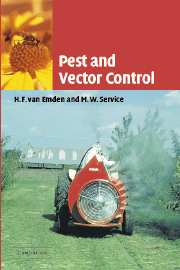Book contents
- Frontmatter
- Contents
- Preface
- 1 Man and insects
- 2 The causes of pest and vectored disease outbreaks
- 3 Insecticides and their formulation
- 4 Application of insecticides
- 5 Problems with insecticides
- 6 Environmental/cultural control
- 7 Biological control
- 8 Insect pathogens
- 9 Genetic control
- 10 Pheromones
- 11 Plant and host resistance
- 12 Other control measures and related topics
- 13 Pest and vector management
- Appendix of names of some chemicals and microbials used as pesticides
- References
- Index
3 - Insecticides and their formulation
Published online by Cambridge University Press: 03 December 2009
- Frontmatter
- Contents
- Preface
- 1 Man and insects
- 2 The causes of pest and vectored disease outbreaks
- 3 Insecticides and their formulation
- 4 Application of insecticides
- 5 Problems with insecticides
- 6 Environmental/cultural control
- 7 Biological control
- 8 Insect pathogens
- 9 Genetic control
- 10 Pheromones
- 11 Plant and host resistance
- 12 Other control measures and related topics
- 13 Pest and vector management
- Appendix of names of some chemicals and microbials used as pesticides
- References
- Index
Summary
Introduction
The history of insecticide usage dates back many centuries, certainly to before 1000 BC, when the burning of sulphur to fumigate houses against pests and illnesses was mentioned by Homer. The insecticidal properties (pyrethrum, see later) of the flower heads of Chrysanthemum cinerariifolium (Fig. 3.1) were first known to the Persians, but were recognized in Europe only in the early nineteenth century. Another group of early insecticides were oils. However, the real landmark in terms of modern agriculture is the spread of the Colorado beetle (Leptinotarsa decemlineata) across the USA in the second half of the nineteenth century (see Chapter 1). Food production and the national economy were both threatened by this potato pest and, after much argument, it was finally decided to take the unprecedented step of spraying the potato crops in North America with a human poison (arsenic in the form of Paris Green). The mass human mortality predicted by the prophets of gloom did not occur, and there is no doubt that control of the Colorado beetle with Paris Green opened the way to a widespread use of biocides (destroyers of life in general) on crops destined for human consumption. In 1921 Paris Green was formulated as a dust that floated on the water surface and acting as a stomach poison killed mosquito larvae, mainly surface-feeding anophelines.
The use of Paris Green was followed by the development as insecticides of a range of existing compounds known to be toxic to man.
- Type
- Chapter
- Information
- Pest and Vector Control , pp. 52 - 76Publisher: Cambridge University PressPrint publication year: 2004



